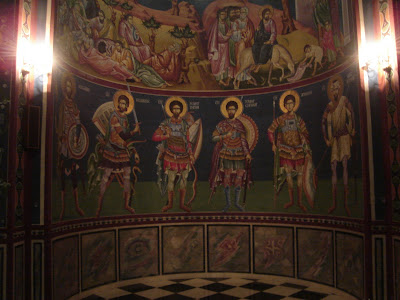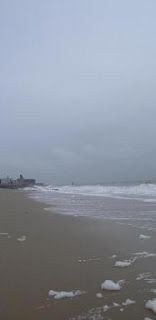The train station in Ljubljana is an imposing Romanesque building painted a pale banana-yogurt yellow. Unlike train stations in, say, Poland, which are invariably grey or granite, always wet and peopled by grim eyeing xenophobes, or in the Netherlands, where careful exuberance is supposed to console the traveler for not having a car, the train station in Ljubljana is clean, bright and dignified. It’s almost eight in the morning. The train will leave at 08:15 and will arrive in Belgrade at 17:20. That's a cool nine hours of Bach, Bryson and peaceful solitude. It's November so I'm not expecting too many travelers.
“I’d like to go to Belgrade,” I whisper shamefully in English to a smiling lady beneath the word INTERNATIONAL. In any other country she would be a mere ticketeer (and behave as such); here she is a seasoned hostess with pride and passion.
|
The train between Ljubljana
and Belgrade |
“Belgrade we got,” she says with a slight touch of an New Jersey accent. I decide not to ask where she acquired it. “That’ll be 49 euro.”
I’m amazed. That amount wouldn’t even get you across a border from any location in the Netherlands. Here it takes you through three countries. I’m so used to last minute airplane travel, that I don’t consider riding trains anymore. Base, of course, thinks differently and has decided that the scope of my experience should be expanded with an international train ride. So be it. Iwana kisses me, wishes me luck and gentle pushes me into the direction of my platform where I’m received by a raincoat type who’s peddling Jehovah’s Witness literature. It appears that in Slovenia too the world is coming to an end.
 |
The fair interior of the train between
Ljubljana and Belgrade |
I should have said hi to the budding beauty sitting opposite of me. The train is about 30 years old but in mint condition, and travelers are cooped up in coupe’s. We’ll be knee to knee for who knows how long, wondering if the other’s noticed that we’re trying to ignore each other. She’s wearing spike heals which can only be very uncomfortable while traveling. Being a practical man myself, I conclude that women do these things to themselves to show the world that they believe that a man would be attracted to somebody who would have to be carried after half a mile of hauling luggage. It’s been long clear to me that my most intimate convictions are automatically published on my forehead, and I really need to break some ice here. That is, if the formation of ice wouldn’t be thwarted by the train’s heating system, which is still working very well, save for the thermostat, which, at some point, must have attracted the attention of itinerant vandals and is now a gnarled stump stuck on hell blaze.

After thirty minutes into the journey the sun breaks through the fog, and raises the temperature in our coupe even more. Nobody is brave enough to open a window and quickly the temperature rises to a near lethal level, although it’s not the temperature that is the enemy. Every person in the coupe, from the prim college girl in my lap to the unshaven drunk to my right, turns into steaming volcanoes of the most repulsive odors. I’m smelling a bouquet of breakfasts waft from all available orifices. The girl’s high heel shoes begin to reek like sneakers, and the mud-streaked clogs of the drunk like the devil’s ass.
The train stops and all of us jump up and try to escape, only to be shoved back in by some heavily armed border boys who want to see our passports, tickets and sweaty faces. Minutes later we are in Zagreb and everybody in my coupe leaves. For twenty blissful seconds I have the place to myself. Contently I arrange my Brysons on the seats around me, my note pad, sandwiches and a bag of apples. My map of Belgrade I spread out over the opposite seats. In one fluent motion my left hand brings my first sandwich to my mouth, my right hand lowers towards the map and as my finger lands on the Belgrade train station, the doors open and a cordon of about fifty young men burst in and spread out over the coupe’s and fill them like water fills holes. There are six seats in my coupe. Seven of these guys squeeze in and settle in where a split second before were the expanse of a map, lunch and literary leverage. It’s not that I hate people. It’s just that I prefer them to come in book form. These seven, who occupy five seats, carry luggage in duffle and gym bags. They wear training suits and gold chains. All of them have crew cuts. Every move they make comes with a series of loud editorials and brutal guttural laughter.
 |
| Wrestling Croatian ninja's on the train |
What would Bill Bryson do?
One of them notices the titles of my books, concludes I’m a stray foreigner and desiring conversation. “Guess what we are?” he says looking at me grinning.
Well, son, you know those little bags of soup? You rip where it says RIP, and the soup comes out from the other end.
“We’re all Jiu-Jitsu champions!” he cheers and slaps his neighbor in the neck. The neighbor jumps up and throws himself upon his violator and a second later I’m dodging the knees and armpits of seven Croatian ninja’s. “We’re on our way to a Jiu-Jitsu tournament!” a muffled voice screams from underneath a mountain of trained flesh.
“Where’s the tournament?” I yell back.
“Beograd!”
“Wonderful…”
They embark on a series of games that in involve lots of screaming and hitting each other on the head with sausages, that were packed for that reason, it seems. I quickly learn that friendship in Croatia revolves largely around producing idiotic howls of heat and displays of fierce violence at the least provocation. “Jiu-Jitsu is great fun,” explains the one guy from under a choke hold. It’s a hybrid of judo, wrestling and lots of loud laughing.
The door slides open and two kids throw themselves on the ninja’s. I estimate them at five and seven years old. They fight like animals and the ninja’s fight back.
“Hey, shouldn’t you be a bit careful with those kids? Who are they anyway?”
“Never mind!” yells the guy, “They’re Gypsies.”
Then they see my camera, resting on my biggest Bill.
“Give me that camera!” yells the oldest one.
“Never!” I scream back.
“Give me that camera you crazy foreign bastard!”
“Over my dead body, you larcenous Gypsy hoodlum!”
The little one grabs my Bill and whacks me on the head with it. The bigger one snatches my camera away and takes off with it. I decide that while the train is still moving, it’s probably safer for everybody that I wait for God to take control of this situation.
 |
| First train station in Serbia |
Close to the Serbian border I get the camera flung back at me. The kids have taken over a hundred photos, most of themselves posing with or without beer bottles, and some very nice ones of other people on the train. It’s all and all a series of photos that I would never have been able to produce myself and I’ll treasure them forever.

In Serbia the train stops more than it goes, and hamlet after hamlet passes by. Then we enter a city that keeps going without an end and I conclude it must be Belgrade. At 17.25 the train comes to a shrieking halt and I exit without ado. On the platform stands my Virgil; a tall blonde woman who speaks British without an accent. We shake hands, and she informs me that we have an appointment some time next week. We’ll be spraying graffiti on a wall somewhere, and this for a very noble cause.

"Take me home, darling," I tell the woman. "I don't care where it is as long as it is peaceful enough to listen to some Bach and maybe read a line or two of Bill Bryson."














































